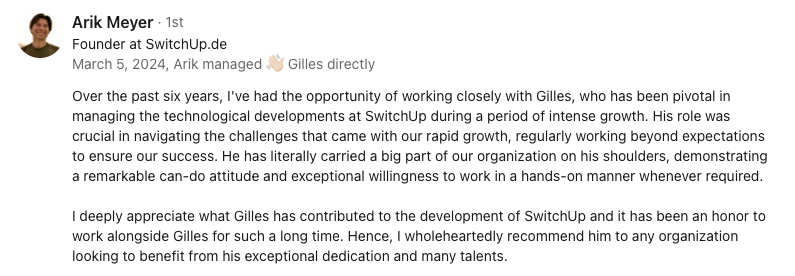Abstract:
The article explores how traditional self-reflection methods often feel unhelpful or vague to those with technical backgrounds, particularly individuals accustomed to structured problem-solving and clear feedback, such as engineers and tech leaders. Drawing from personal experience leading teams across different cultures—including managing recurring anxieties during high-stakes projects in Beijing and navigating imposter syndrome while scaling a company in Berlin—the author describes how reframing mindset challenges as "mental bugs" can make introspection both approachable and productive. By treating thoughts and emotions like software issues to be logged, traced, and iteratively fixed, the author employs familiar tools like incident templates, root cause analysis, and kanban boards to track and resolve recurring mental patterns such as perfectionism or self-doubt. Brief, concrete prompts and the integration of reflection into existing workflows—like maintaining a personal changelog alongside daily tasks—help maintain momentum without feeling burdensome. This structured, curious approach not only demystifies personal growth but also demonstrates that steady, incremental "debugging" leads to lasting improvements in both mindset and professional effectiveness.
You know the feeling: the tools that make sense in tech rarely help when I try to sort out my own mind. If someone hands me a blank journal and says just reflect, it feels like debugging a server with no logs. I spend my days solving concrete problems, so this fuzzy approach can seem pointless. Structure and clear outcomes matter to me. Clear starting points and obvious fixes—that’s my comfort zone.
I have led teams and projects across cultures, and the mental glitches that appear, such as imposter syndrome or perfectionism, stick around like any stubborn production issue. Traditional introspection felt like running code that prints nothing. The good news is that I found a way to make mindset work as logical as debugging. When thoughts and emotions look like system errors I can inspect, log, and patch, the whole exercise turns familiar, almost playful.
If journaling has ever seemed like busywork, you are not alone. With the right structure it becomes just another technical challenge, solved one small fix at a time.
Debugging your mind like your code
Why classic reflection fails tech minds
People who think in code often bump into mental bugs such as imposter syndrome, harsh self-criticism, or perfectionism. Sitting down to just write your feelings can feel like untangling spaghetti code without comments. We want clear feedback and cause-effect links. Open-ended prompts often miss the mark. Our industry rewards logic and quick, visible results, so a process with no measurable outcome feels empty.
Journaling and introspection feel like running code with no output
In my world logic pays the bills. Whether I am pitching a new idea or fixing a server, I rely on structure and feedback. Classic journaling looked like a program that returns nothing, so I ignored it for years. I saw many colleagues do the same. Time spent on a fuzzy activity seemed lost for building, shipping, or learning.
Debugging your thoughts turns mindset work into an engineering problem
The switch happened when I decided to treat mindset work like any other system. My physics background and years in product helped. Thought patterns became another layer of code with bugs to hunt. Self-reflection turned into technical growth. When I started tracing mental errors with the same care I give production issues, progress followed.
Making mental bugs as clear as code bugs
Naming the invisible how emotional glitches show up in tech
Digital bugs scream in red logs. Mental ones hide. Honestly, imposter syndrome feels like an unhandled exception that crashes confidence. Perfectionism loops forever, never reaching done. Stereotype threat drains focus like a memory leak. Seeing these struggles as system bugs shrinks them to size. They become repeatable problems that I can log and fix.
When recurring thoughts become production issues
While managing teams in Beijing I saw these bugs often. Doubts resurfaced near release days and big meetings. At first I brushed them off. Later I noticed the pattern resembled a code issue that fails every integration test. Recurrence signaled something systemic.
- Not good enough to lead this team
- If this pitch fails everyone will think I am lucky
- Why can’t I finish this project flawlessly
- Worry about inconsistent income when a client pauses a project
Now the anxiety is a backlog. Track, analyze, patch—same process as code.
Turning vague anxiety into concrete error logs
Writing the bugs down helps. Once a worry moves from my head to a list it loses force. A few lines often appear:
- Not good enough to lead this team
- If this pitch fails everyone will think I am lucky
- Why can’t I finish this project flawlessly
Now the anxiety is a backlog. Track, analyze, patch—same process as code.
A practical framework for debugging your mind
Log the issue like a real bug
When an unhelpful thought shows up I write it down, no drama, just facts. It joins a list that waits for analysis. The weight drops the moment it lands on paper or in a note.
Trace the cause with technical prompts
I retrace the steps in my mind. What sparked the feeling? A sharp comment during standup? A looming deadline? Is it new or a repeat offender? Typical prompts:
- What happened right before?
- Have I seen this before?
- What do I usually do next?
Track patterns and recurring error messages
I label each entry and record when it appears:
- Imposter mode before every major release
- Perfectionism spike during documentation
- Worry about perception after code review
After a few weeks it is clear which bugs deserve deeper work.
Building a weekly Win-Log routineTo keep progress visible, I use a simple weekly routine: on Monday mornings, I review my Win-Log—a short list of last week’s mindset wins and resolved worries. On Fridays, I do a quick retro with three prompts: What went well? What challenged me? What’s one thing to try next week? This habit keeps reflection regular and the process grounded.
Break big feelings into manageable pieces
Next I dissect the event:
- What did I fear would happen next?
- Which outcome scares me, public failure or missed target?
- Has this shown up before?
The feeling becomes a set of variables I can test.
Ask “why” until the real root shows up
Borrowing from root cause analysis I keep asking why. An anxious presentation might trace back to rushed prep, which links to a packed sprint, which points to poor planning. Each level moves closer to the real issue. Research shows that even 15 minutes of daily reflection can lead to a 23% drop in reported stress levels, making this process more than just a mental exercise—it’s evidence-backed.
Shrink the problem to a size I can fix
Reaching the source turns big worries into small tasks. Maybe I need blocked prep time or a better backlog. Sometimes an old belief needs attention.
Test beliefs and check the mental logic
I run unit tests on old stories:
- What facts support this belief?
- Are there times the opposite was true?
- Would I say this to a teammate?
Data calms emotion. If the logic fails, time to rewrite.
Refactor the narrative, don’t just suppress
Instead of saying I always fail at presentations, I replace it with I get nervous, yet I have led successful meetings, and practice helps. Like cleaning code, I improve rather than erase history.
Treat every fix as a small upgrade
Mindset work is never finished. Each pass is another commit. Slow progress still counts, learning beats perfection.
Everyday mind debugging made easy
Prompts that feel like troubleshooting, not therapy
Quick, concrete questions work best:
- What triggered this thought, can I reproduce it?
- What is the root cause, can I use Five Whys?
- Is this a pattern or a one off?
- Does the feeling pass a logic test?
I also use a brief incident template:
- Incident: what happened
- Hypothesis: likely root cause
- Test: small experiment
- Resolution: result of the experiment
Sometimes, instead of debugging, I think of my mind like a piece of wood in my carpentry shed. Each anxious thought is a rough patch. With every pass—like sanding wood layer by layer—I smooth things out. It’s slow, but over time, the surface feels better to the touch.
Building reflection into daily workflows
I keep a personal changelog next to my task list. Each mental bug fixed earns a line. Moving a card from to debug to resolved on a simple Kanban board feels good. Typical cards:
- Challenge belief about not being good enough
- Reframe a worrying thought with facts
- Track mindset wins from the week
Sometimes I walk in the countryside near Lisbon and jot quick notes. Folding reflection into habits I already trust keeps it light.
Debugging the mind in real time
Facing down imposter syndrome during transformation
Scaling a company in Berlin brought the loudest bug: imposter syndrome. While guiding a major transformation project with new stakeholders and high pressure, the thought kept repeating, Soon they will notice I do not have all the answers. My palms tingled and my French accent slipped on every word, making the anxiety feel even more real. The feeling had survived every prior patch. Treating it like a technical issue was the only path forward.
Breaking the problem into triggers and root causes
I logged the bug: anxious before all hands. Then I listed triggers:
- New team dynamics
- High project stakes
- Unfamiliar tech stack
Five Whys exposed a deeper worry about leading in a new city under high expectations.
Testing assumptions and refactoring my inner logic
Next I tested the belief. Had I failed catastrophically before? No. The team grew and projects shipped. The script did not match the data. I rewrote it: It is fine not to know everything. My role is to keep learning.
Watching the bug frequency drop
Over the next weeks the error frequency fell. Fewer anxious mornings, better focus, honest feedback loops closed without spiraling. Each win logged, each fix another step toward a calmer, more reliable version of myself.
Growing through small improvements
Building progress, one tweak at a time
No codebase is perfect, and the same goes for the mind. Small, steady upgrades beat massive overhauls. The kaizen idea of tiny continuous steps keeps burnout away and builds durable change.
Setbacks as signals, not stop signs
When an old bug returns I treat it as a signal, not a failure. It tells me where to run the next test.
Progress leaves a real trail
My changelog shows wins, stumbles, and experiments. Confidence comes from tracking both. Mindset work looks like any project: document, test, tweak, repeat. Over time the commits add up.
Debugging my mind with structured curiosity changed my work and life. Turning thoughts into log entries, tracing them, and patching the logic made self-reflection clear and even fun. Simple prompts, quick templates, and a habit of tracking wins keep improvement moving in small, steady steps. Each bug fixed is a real upgrade, and the process never stops.














